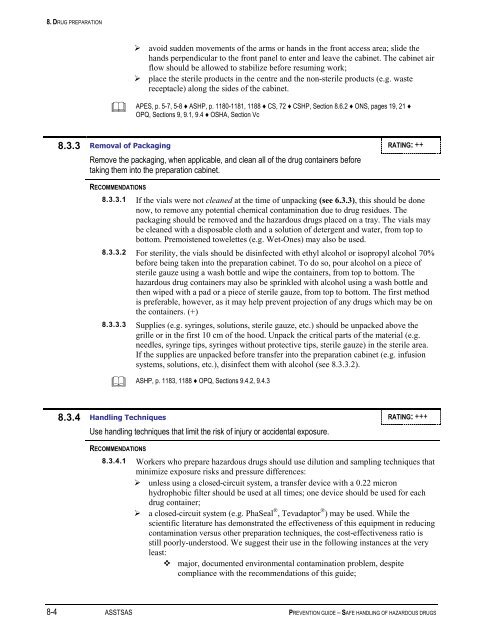Prevention Guide - Safe Handling of Hazardous Drugs - Irsst
Prevention Guide - Safe Handling of Hazardous Drugs - Irsst
Prevention Guide - Safe Handling of Hazardous Drugs - Irsst
Create successful ePaper yourself
Turn your PDF publications into a flip-book with our unique Google optimized e-Paper software.
8. DRUG PREPARATION<br />
‣ avoid sudden movements <strong>of</strong> the arms or hands in the front access area; slide the<br />
hands perpendicular to the front panel to enter and leave the cabinet. The cabinet air<br />
flow should be allowed to stabilize before resuming work;<br />
‣ place the sterile products in the centre and the non-sterile products (e.g. waste<br />
receptacle) along the sides <strong>of</strong> the cabinet.<br />
<br />
APES, p. 5-7, 5-8 ♦ ASHP, p. 1180-1181, 1188 ♦ CS, 72 ♦ CSHP, Section 8.6.2 ♦ ONS, pages 19, 21 ♦<br />
OPQ, Sections 9, 9.1, 9.4 ♦ OSHA, Section Vc<br />
8.3.3 Removal <strong>of</strong> Packaging RATING: ++<br />
Remove the packaging, when applicable, and clean all <strong>of</strong> the drug containers before<br />
taking them into the preparation cabinet.<br />
RECOMMENDATIONS<br />
8.3.3.1 If the vials were not cleaned at the time <strong>of</strong> unpacking (see 6.3.3), this should be done<br />
now, to remove any potential chemical contamination due to drug residues. The<br />
packaging should be removed and the hazardous drugs placed on a tray. The vials may<br />
be cleaned with a disposable cloth and a solution <strong>of</strong> detergent and water, from top to<br />
bottom. Premoistened towelettes (e.g. Wet-Ones) may also be used.<br />
8.3.3.2 For sterility, the vials should be disinfected with ethyl alcohol or isopropyl alcohol 70%<br />
before being taken into the preparation cabinet. To do so, pour alcohol on a piece <strong>of</strong><br />
sterile gauze using a wash bottle and wipe the containers, from top to bottom. The<br />
hazardous drug containers may also be sprinkled with alcohol using a wash bottle and<br />
then wiped with a pad or a piece <strong>of</strong> sterile gauze, from top to bottom. The first method<br />
is preferable, however, as it may help prevent projection <strong>of</strong> any drugs which may be on<br />
the containers. (+)<br />
8.3.3.3 Supplies (e.g. syringes, solutions, sterile gauze, etc.) should be unpacked above the<br />
grille or in the first 10 cm <strong>of</strong> the hood. Unpack the critical parts <strong>of</strong> the material (e.g.<br />
needles, syringe tips, syringes without protective tips, sterile gauze) in the sterile area.<br />
If the supplies are unpacked before transfer into the preparation cabinet (e.g. infusion<br />
systems, solutions, etc.), disinfect them with alcohol (see 8.3.3.2).<br />
<br />
ASHP, p. 1183, 1188 ♦ OPQ, Sections 9.4.2, 9.4.3<br />
8.3.4 <strong>Handling</strong> Techniques RATING: +++<br />
Use handling techniques that limit the risk <strong>of</strong> injury or accidental exposure.<br />
RECOMMENDATIONS<br />
8.3.4.1 Workers who prepare hazardous drugs should use dilution and sampling techniques that<br />
minimize exposure risks and pressure differences:<br />
‣ unless using a closed-circuit system, a transfer device with a 0.22 micron<br />
hydrophobic filter should be used at all times; one device should be used for each<br />
drug container;<br />
‣ a closed-circuit system (e.g. PhaSeal ® , Tevadaptor ® ) may be used. While the<br />
scientific literature has demonstrated the effectiveness <strong>of</strong> this equipment in reducing<br />
contamination versus other preparation techniques, the cost-effectiveness ratio is<br />
still poorly-understood. We suggest their use in the following instances at the very<br />
least:<br />
major, documented environmental contamination problem, despite<br />
compliance with the recommendations <strong>of</strong> this guide;<br />
8-4 ASSTSAS PREVENTION GUIDE – SAFE HANDLING OF HAZARDOUS DRUGS

















